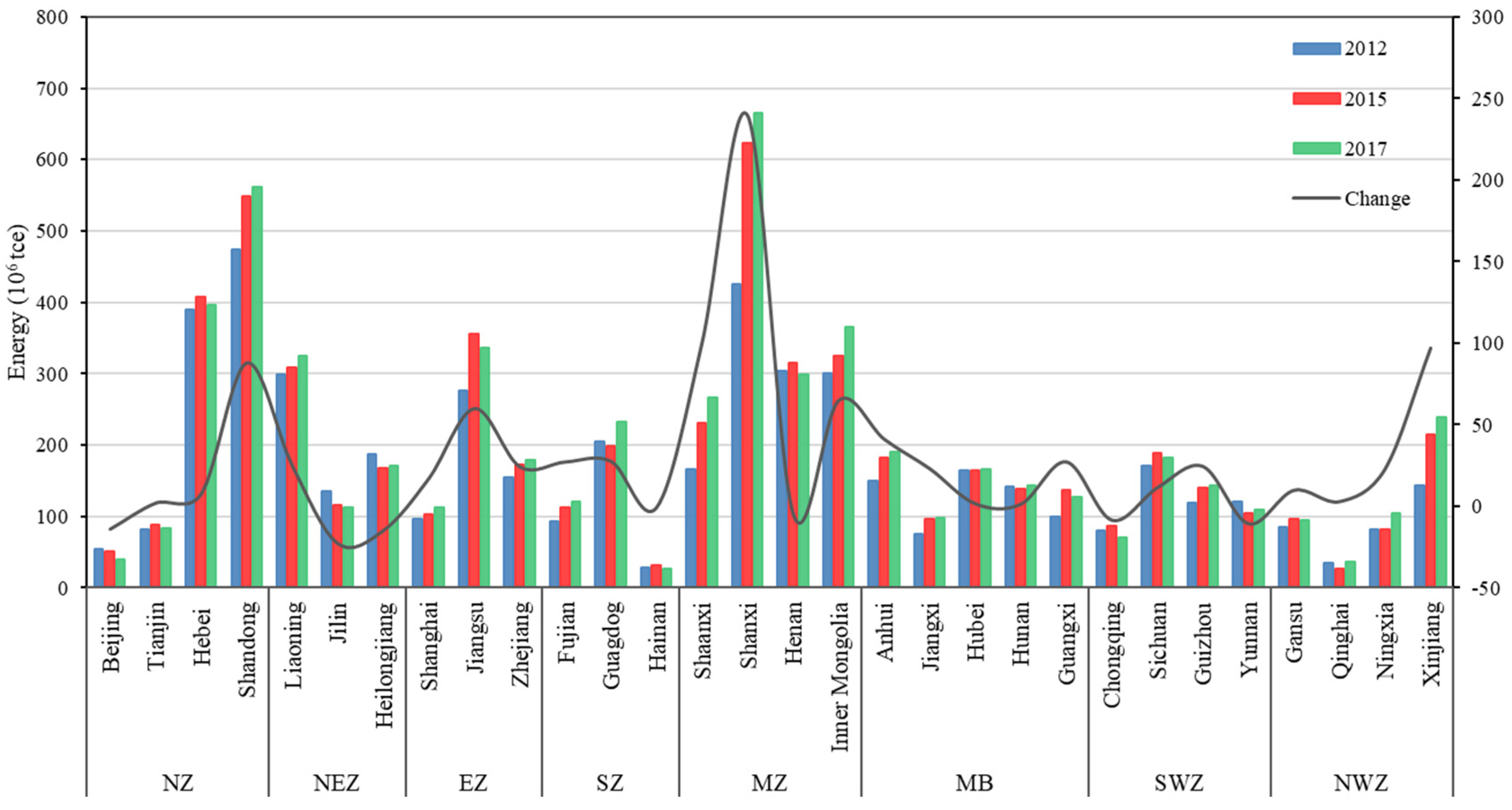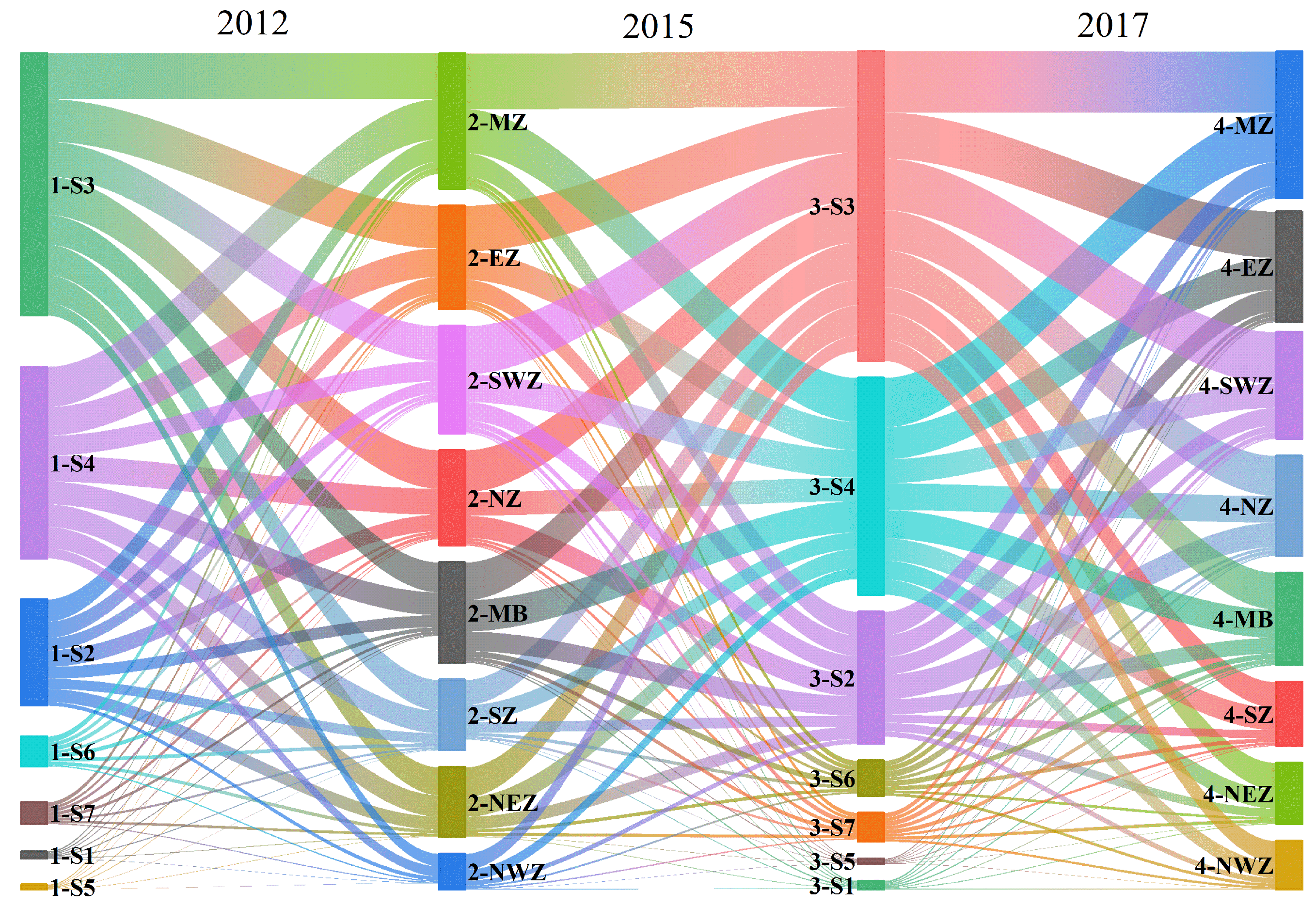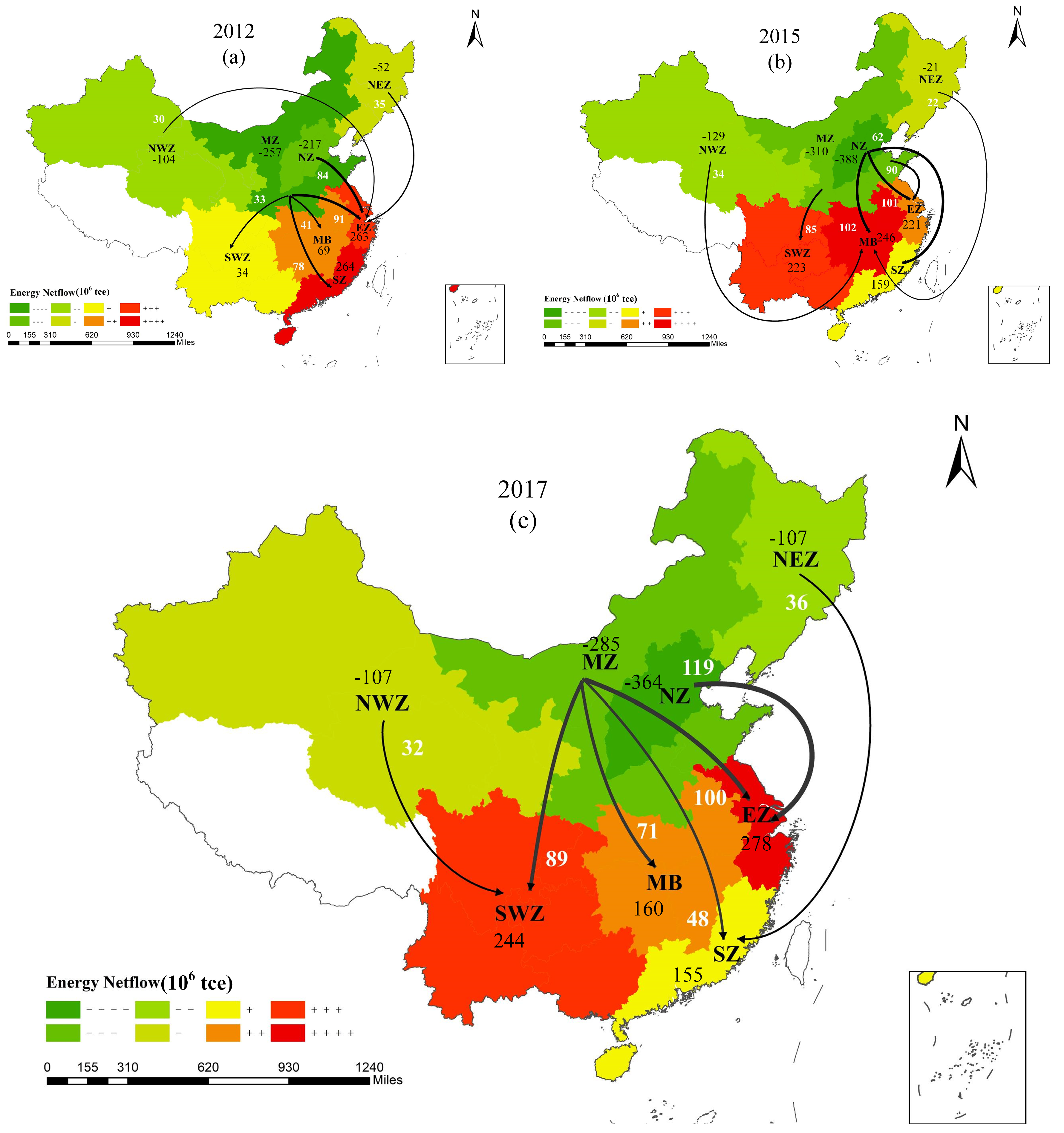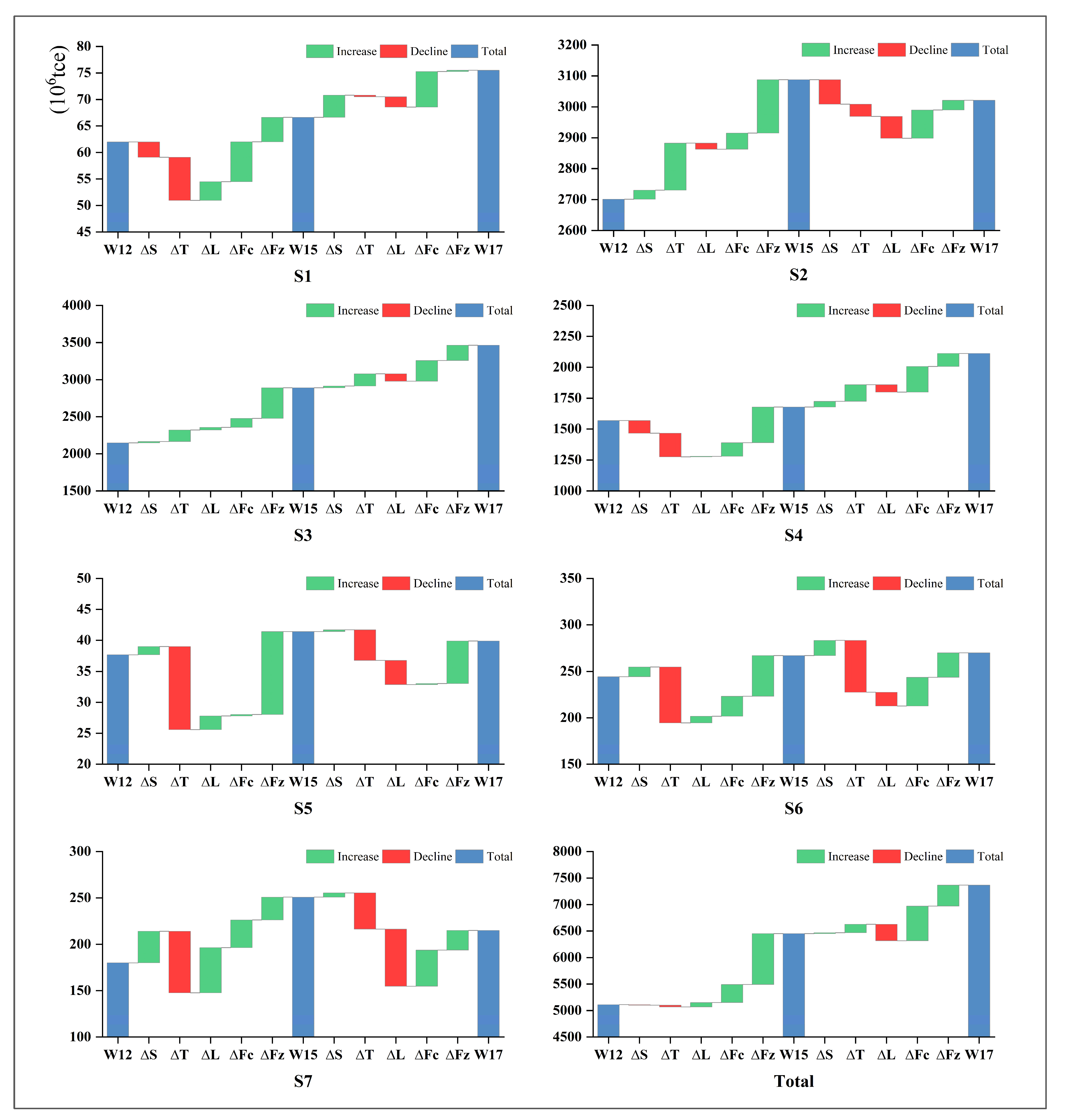Spatial–Temporal Evolution Patterns and Drivers of Embodied Energy Transfer Along with Industrial Transfer in China: From a Regional–Sectoral Perspective
Abstract
1. Introduction
2. Literature Review
3. Methodology and Data
3.1. The MRIO Method
3.2. The SDA Method
3.3. Data Sources
4. Results Analysis
4.1. Industrial Consumption and Embodied Energy Consumption
4.2. Industrial and Embodied Energy Transfers
4.3. Evolution Patterns of Net Industrial Transfer and Net Embodied Energy Transfer
4.3.1. Spatial–Temporal Paths of Net Industrial Transfer
4.3.2. Spatial–Temporal Paths of Net Embodied Energy Transfer
4.3.3. Comparative Analysis of the Evolution Patterns
4.4. Decomposition of Drivers of Embodied Energy Change
4.4.1. Regional-Level Drivers
4.4.2. Sectoral-Level Drivers
4.5. Discussion
5. Conclusions and Policy Implications
- (1)
- The middle Yellow River comprehensive zone is the most important area of embodied energy and industrial consumption, with Manufacturing (S3) being the main sector experiencing growth in both industry and embodied energy consumption. By 2017, industrial transfer has increased by nearly 60.10%. However, the embodied energy consumption growth rate has declined. Manufacturing (S3), Electricity, hot water, gas, and water production and supply (S4) were the highest consumer sectors of embodied energy.
- (2)
- The directions of embodied energy transfer with industrial transfer are not perfectly consistent. The paths of net industrial transfer were primarily from the developed coastal regions in the east and north and were directed toward the inland developing middle and western regions. The middle and western regions are the leading contributors to embodied energy transfer in other regions. The net embodied energy transfer paths primarily originated in the middle and northwest and directly flowed into the developed coastal regions. Regional disparities can be observed: economy and industry in the middle and western regions are developing slowly, so it mainly exports embodied energy to developed regions. Meanwhile, the highly developed regions of the southern and coastal zones consume a lot of embodied energy, which leads to import and transfer.
- (3)
- In the sectoral and regional analysis of drivers, energy intensity and production structure effects are the major inhibiting factors. Final consumption and investment are the main factors promoting embodied energy change, indicating that the existing production and consumption still involve high embodied energy use. The rapid economic development in the developed regions has driven the consumer market and generated significant energy demand. It, in turn, has resulted in the agglomeration of industries with low energy efficiency in developing regions, ultimately affecting the embodied energy consumption and transfer between regions. These trends pose significant challenges to the realization of the “dual control of energy” goal.
Author Contributions
Funding
Data Availability Statement
Acknowledgments
Conflicts of Interest
References
- Wang, Z.; Zhang, H.; Li, H.; Wang, S.; Wang, Z. Identifying the key factors to China’s unsustainable external circulation through the accounting of the flow of embodied energy and virtual water. Renew. Sustain. Energy Rev. 2023, 173, 113115. [Google Scholar] [CrossRef]
- Chen, G.Q.; Wu, X.F. Energy overview for globalized world economy: Source, supply chain and sink. Renew. Sustain. Energy Rev. 2017, 69, 735–749. [Google Scholar] [CrossRef]
- Yongwei, C.; Dong, M.; Huanyu, R.; Tijun, F.; Jianbang, D. Using a temporal input-output approach to analyze the ripple effect of China’s energy consumption. Energy 2020, 211, 118641. [Google Scholar] [CrossRef]
- Zhao, X.; Lu, F. Spatial distribution characteristics and convergence of China’s regional energy intensity: An industrial transfer perspective. J. Clean. Prod. 2019, 233, 903–917. [Google Scholar] [CrossRef]
- Li, Y.; Sun, L.; Zhang, H.; Liu, T.; Fang, K. Does industrial transfer within urban agglomerations promote dual control of total energy consumption and energy intensity? J. Clean. Prod. 2018, 204, 607–617. [Google Scholar] [CrossRef]
- Xue, L.; Li, H.; Xu, C.; Zhao, X.; Zheng, Z.; Li, Y.; Liu, W. Impacts of industrial structure adjustment, upgrade and coordination on energy efficiency: Empirical research based on the extended STIRPAT model. Energy Strategy Rev. 2022, 43, 100911. [Google Scholar] [CrossRef]
- Zhan, L.; Lei, Y.; Li, L.; Ge, J. Interprovincial transfer of ecological footprint among the region of Jing-Jin-Ji and other provinces in China: A quantification based on MRIO model. J. Clean. Prod. 2019, 225, 304–314. [Google Scholar] [CrossRef]
- Wang, X.; Huang, H.; Hong, J.; Ni, D.; He, R. A spatiotemporal investigation of energy-driven factors in China: A region-based structural decomposition analysis. Energy 2020, 207, 118249. [Google Scholar] [CrossRef]
- Li, M.; Li, Q.; Wang, Y.; Chen, W. Spatial path and determinants of carbon transfer in the process of inter provincial industrial transfer in China. Environ. Impact Assess. Rev. 2022, 95, 106810. [Google Scholar] [CrossRef]
- Zhang, Z.; Chen, W. Embodied carbon transfer between China and the Belt and Road Initiative countries. J. Clean. Prod. 2022, 378, 134569. [Google Scholar] [CrossRef]
- Mi, Z.; Meng, J.; Guan, D.; Shan, Y.; Song, M.; Wei, Y.M.; Liu, Z.; Hubacek, K. Chinese CO2 emission flows have reversed since the global financial crisis. Nat. Commun. 2017, 8, 1712. [Google Scholar] [CrossRef] [PubMed]
- Liu, H.; Liu, W.; Liu, Z. Quantitative measurement of interregional Industrial Transfer—Based on Interregional input-output table analysis. China Ind. Econ. 2011, 6, 79–88. [Google Scholar] [CrossRef]
- Yin, J.; Zheng, M.; Li, X. Interregional transfer of polluting industries: A consumption responsibility perspective. J. Clean. Prod. 2016, 112, 4318–4328. [Google Scholar] [CrossRef]
- Liu, C.; Hong, T.; Li, H.; Wang, L. From club convergence of per capita industrial pollutant emissions to industrial transfer effects: An empirical study across 285 cities in China. Energy Policy 2018, 121, 300–313. [Google Scholar] [CrossRef]
- Omri, A.; Kahouli, B. Causal relationships between energy consumption, foreign direct investment and economic growth: Fresh evidence from dynamic simultaneous-equations models. Energy Policy 2014, 67, 913–922. [Google Scholar] [CrossRef]
- Yang, R.; Long, R.; Yue, T.; Shi, H. Calculation of embodied energy in Sino-USA trade: 1997–2011. Energy Policy 2014, 72, 110–119. [Google Scholar] [CrossRef]
- Abbes, S.M.; Mostéfa, B.; Seghir, G.; Zakarya, G.Y. Causal Interactions between FDI, and Economic Growth: Evidence from Dynamic Panel Co-integration. Procedia Econ. Financ. 2015, 23, 276–290. [Google Scholar] [CrossRef]
- Rahman, M.M.; Mamun, S.A.K. Energy use, international trade and economic growth nexus in Australia: New evidence from an extended growth model. Renew. Sustain. Energy Rev. 2016, 64, 806–816. [Google Scholar] [CrossRef]
- Shi, X.; Chu, J.; Zhao, C. Exploring the spatiotemporal evolution of energy intensity in China by visual technology of the GIS. Energy 2021, 228, 120650. [Google Scholar] [CrossRef]
- Zhang, B.; Chen, Z.M.; Xia, X.H.; Xu, X.Y.; Chen, Y.B. The impact of domestic trade on China’s regional energy uses: A multi-regional input–output modeling. Energy Policy 2013, 63, 1169–1181. [Google Scholar] [CrossRef]
- Zhang, B.; Qiao, H.; Chen, Z.M.; Chen, B. Growth in embodied energy transfers via China’s domestic trade: Evidence from multi-regional input–output analysis. Appl. Energy 2016, 184, 1093–1105. [Google Scholar] [CrossRef]
- Chen, L.; Xu, L.; Yang, Z. Accounting carbon emission changes under regional industrial transfer in an urban agglomeration in China’s Pearl River Delta. J. Clean. Prod. 2017, 167, 110–119. [Google Scholar] [CrossRef]
- Zheng, Y.; Qi, J.; Chen, X. The effect of increasing exports on industrial energy intensity in China. Energy Policy 2011, 39, 2688–2698. [Google Scholar] [CrossRef]
- Wang, Y.; Wang, X.; Chen, W.; Qiu, L.; Wang, B.; Niu, W. Exploring the path of inter-provincial industrial transfer and carbon transfer in China via combination of multi-regional input–output and geographically weighted regression model. Ecol. Indic. 2021, 125, 107547. [Google Scholar] [CrossRef]
- Pan, A.; Xiao, T.; Dai, L.; Shi, X. Global transfer of embodied energy: From source to sink through global value chains. Sustain. Prod. Consum. 2022, 31, 39–51. [Google Scholar] [CrossRef]
- Li, Y.; Chen, B.; Li, C.; Li, Z.; Chen, G. Energy perspective of Sino-US trade imbalance in global supply chains. Energy Econ. 2020, 92, 104959. [Google Scholar] [CrossRef]
- Wu, X.F.; Chen, G.Q. Coal use embodied in globalized world economy: From source to sink through supply chain. Renew. Sustain. Energy Rev. 2018, 81, 978–993. [Google Scholar] [CrossRef]
- He, H.; Reynolds, C.J.; Li, L.; Boland, J. Assessing net energy consumption of Australian economy from 2004–05 to 2014–15: Environmentally-extended input-output analysis, structural decomposition analysis, and linkage analysis. Appl. Energy 2019, 240, 766–777. [Google Scholar] [CrossRef]
- Ren, B.; Li, H.; Shi, J.; Liu, Y.; Qi, Y. Identifying the key sectors and paths of the embodied energy in BRICS nations: A weighted multilayer network approach. Energy 2022, 239, 122091. [Google Scholar] [CrossRef]
- Sun, X.; Li, J.; Qiao, H.; Zhang, B. Energy implications of China’s regional development: New insights from multi-regional input-output analysis. Appl. Energy 2017, 196, 118–131. [Google Scholar] [CrossRef]
- Zhang, X.; Su, B.; Yang, J.; Cong, J. Analysis of Shanxi Province’s energy consumption and intensity using input-output framework (2002–2017). Energy 2022, 250, 123786. [Google Scholar] [CrossRef]
- Zhang, K.; Lu, H.; Tian, P.; Guan, Y.; Kang, Y.; He, L.; Fan, X. Analysis of the relationship between water and energy in China based on a multi-regional input-output method. J. Environ. Manag. 2022, 309, 114680. [Google Scholar] [CrossRef] [PubMed]
- Zhang, P.; Zhou, Y.; Xie, Y.; Wang, Y.; Li, B.; Li, B.; Jia, Q.; Yang, Z.; Cai, Y. Assessment of the water-energy-food nexus under spatial and social complexities: A case study of Guangdong-Hong Kong-Macao. J. Environ. Manag. 2021, 299, 113664. [Google Scholar] [CrossRef] [PubMed]
- Song, S.; Chen, X.; Liu, T.; Zan, C.; Hu, Z.; Huang, S.; De Maeyer, P.; Wang, M.; Sun, Y. Indicator-based assessments of the coupling coordination degree and correlations of water-energy-food-ecology nexus in Uzbekistan. J. Environ. Manag. 2023, 345, 118674. [Google Scholar] [CrossRef]
- Wang, Q.; Liu, Y. India’s renewable energy: New insights from multi-regional input output and structural decomposition analysis. J. Clean. Prod. 2021, 283, 124230. [Google Scholar] [CrossRef]
- Wu, Y.; Huang, H.; Hong, J.; Wang, X.; Wu, Y.; Wu, Y. Transfer patterns and driving factors of China’s energy use in trade: Evidence from multiregional input–output analysis and structural decomposition analysis. Energy Rep. 2022, 8, 10963–10975. [Google Scholar] [CrossRef]
- Dong, B.; Xu, Y.; Li, Q. Carbon transfer under China’s inter-provincial trade: Evaluation and driving factors. Sustain. Prod. Consum. 2022, 32, 378–392. [Google Scholar] [CrossRef]
- Pang, Q.; Dong, X.; Zhang, L.; Chiu, Y.-H. Drivers and key pathways of the household energy consumption in the Yangtze river economic belt. Energy 2023, 262, 125404. [Google Scholar] [CrossRef]
- Wang, Z.; Cui, C.; Peng, S. How do urbanization and consumption patterns affect carbon emissions in China? A decomposition analysis. J. Clean. Prod. 2019, 211, 1201–1208. [Google Scholar] [CrossRef]
- Amin, S.; Jamasb, T.; Nepal, R. Regulatory reform and the relative efficacy of government versus private investment on energy consumption in South Asia. Econ. Anal. Policy 2021, 69, 421–433. [Google Scholar] [CrossRef]
- Zhu, B.; Su, B.; Li, Y.; Ng, T.S. Embodied energy and intensity in China’s (normal and processing) exports and their driving forces, 2005–2015. Energy Econ 2020, 91, 104911. [Google Scholar] [CrossRef] [PubMed]
- Tang, M.; Hong, J.; Liu, G.; Shen, G.Q. Exploring energy flows embodied in China’s economy from the regional and sectoral perspectives via combination of multi-regional input–output analysis and a complex network approach. Energy 2019, 170, 1191–1201. [Google Scholar] [CrossRef]
- Wang, X.-C.; Yang, L.; Wang, Y.; Klemeš, J.J.; Varbanov, P.S.; Ouyang, X.; Dong, X. Imbalances in virtual energy transfer network of China and carbon emissions neutrality implications. Energy 2022, 254, 124304. [Google Scholar] [CrossRef]
- Li, X.; Zeng, Z.; Zhang, Z.; Yao, Y.; Du, H. The rising North-South carbon flows within China from 2012 to 2017. Struct. Change Econ. Dyn. 2023, 64, 263–272. [Google Scholar] [CrossRef]
- Li, W.; Wang, Q.; Jin, B.; Li, G.; Su, B. Multiregional input–output analysis of carbon transfer in interprovincial trade and sectoral strategies for mitigation: Case study of Shanxi province in China. J. Clean. Prod. 2023, 391, 136220. [Google Scholar] [CrossRef]
- Dong, S.; Xia, B.; Li, F.; Cheng, H.; Li, Z.; Li, Y.; Zhang, W.; Yang, Y.; Liu, Q.; Li, S. Spatial–temporal pattern, driving mechanism and optimization policies for embodied carbon emissions transfers in multi-regional tourism: Case study of provinces in China. J. Clean. Prod. 2023, 382, 135362. [Google Scholar] [CrossRef]
- Yan, J.; Li, Y.; Su, B.; Ng, T.S. Contributors and drivers of Chinese energy use and intensity from regional and demand perspectives, 2012–2015–2017. Energy Econ. 2022, 115, 106357. [Google Scholar] [CrossRef]
- Yang, S.; Shi, L. Prediction of long-term energy consumption trends under the New National Urbanization Plan in China. J. Clean. Prod. 2017, 166, 1144–1153. [Google Scholar] [CrossRef]
- Yan, J.; Su, B. What drive the changes in China’s energy consumption and intensity during 12th Five-Year Plan period? Energy Policy 2020, 140, 111383. [Google Scholar] [CrossRef]
- Li, Q.; Wu, S.; Lei, Y.; Li, S.; Li, L. Evolutionary path and driving forces of inter-industry transfer of CO2 emissions in China: Evidence from structural path and decomposition analysis. Sci. Total Environ. 2021, 765, 142773. [Google Scholar] [CrossRef]










| Codes | Sectors | Codes | Departments |
|---|---|---|---|
| S1 | Agriculture | D1 | Farming, Forestry, Animal Husbandry, and Fishery |
| S2 | Mining | D2 | Coal mining and washing |
| D3 | Petroleum and Natural Gas Extraction | ||
| D4 | Metals Mining and Dressing | ||
| D5 | Nonmetal and other Minerals Mining and Dressing | ||
| S3 | Manufacturing | D6 | Food, Beverage, and Tobacco Processing and Production |
| D7 | Textile Industry | ||
| D8 | Fiber, Leather, Furs, and related products. | ||
| D9 | Timber Processing, Bamboo, Cane, Palm Fiber, Straw Products, and Furniture Manufacturing | ||
| D10 | Paper Making, Printing, and Related Products, Cultural, Educational, and Sports Articles | ||
| D11 | Petroleum Processing and Coking | ||
| D12 | Chemical and Pharmaceutical Products, Chemical Fiber, Rubber, and Plastic Products | ||
| D13 | Nonmetal Mineral Products | ||
| D14 | Smelting and Pressing of Metals | ||
| D15 | Metal Products | ||
| D16 | Ordinary Machinery | ||
| D17 | Equipment for Special Purpose | ||
| D18 | Transportation Equipment | ||
| D19 | Electric Equipment and Machinery | ||
| D20 | Electronic and Telecommunication Equipment | ||
| D21 | Instruments, Meters, Cultural and Office Machinery | ||
| D22 | Other Manufacturing Industry | ||
| D23 | Metal products, machinery, and equipment repair services | ||
| S4 | Electricity, hot water, gas, and water production and supply | D24 | Electric Power, Steam, and Hot Water Production and Supply |
| D25 | Gas Production and Supply | ||
| D26 | Production and Supply of Tap Water | ||
| S5 | Construction | D27 | Construction |
| S6 | Transportation | D28 | Transportation, Storage, Post and Telecommunication Services |
| S7 | Services | D29 | Wholesale, Retail trade, Accommodation, and Catering |
| D30 | Other Services |
| Abbreviate | Regions | Provinces |
|---|---|---|
| NZ | Northern coastal comprehensive economic zone | Beijing, Tianjin, Hebei, Shandong |
| NEZ | Northeast comprehensive economic zone | Liaoning, Jilin, Heilongjiang |
| EZ | Eastern coastal comprehensive economic zone | Shanghai, Jiangsu, Zhejiang |
| SZ | Southern coastal economic zone | Fujian, Hainan, Guangdong |
| MZ | Middle Yellow River comprehensive economic zone | Shaanxi, Shanxi, Henan, Inner Mongolia |
| MB | Middle Yangtze River comprehensive economic belt | Hubei, Hunan, Jiangxi, Anhui |
| SWZ | Southwest comprehensive economic zone | Yunnan, Guizhou, Sichuan, Chongqing, Guangxi |
| NWZ | Northwest comprehensive economic zone | Gansu, Qinghai, Ningxia, Xinjiang |
Disclaimer/Publisher’s Note: The statements, opinions and data contained in all publications are solely those of the individual author(s) and contributor(s) and not of MDPI and/or the editor(s). MDPI and/or the editor(s) disclaim responsibility for any injury to people or property resulting from any ideas, methods, instructions or products referred to in the content. |
© 2025 by the authors. Licensee MDPI, Basel, Switzerland. This article is an open access article distributed under the terms and conditions of the Creative Commons Attribution (CC BY) license (https://creativecommons.org/licenses/by/4.0/).
Share and Cite
Pang, Q.; Lv, X.; Zhang, L.; Chiu, Y. Spatial–Temporal Evolution Patterns and Drivers of Embodied Energy Transfer Along with Industrial Transfer in China: From a Regional–Sectoral Perspective. Energies 2025, 18, 1965. https://doi.org/10.3390/en18081965
Pang Q, Lv X, Zhang L, Chiu Y. Spatial–Temporal Evolution Patterns and Drivers of Embodied Energy Transfer Along with Industrial Transfer in China: From a Regional–Sectoral Perspective. Energies. 2025; 18(8):1965. https://doi.org/10.3390/en18081965
Chicago/Turabian StylePang, Qinghua, Xueping Lv, Lina Zhang, and Yungho Chiu. 2025. "Spatial–Temporal Evolution Patterns and Drivers of Embodied Energy Transfer Along with Industrial Transfer in China: From a Regional–Sectoral Perspective" Energies 18, no. 8: 1965. https://doi.org/10.3390/en18081965
APA StylePang, Q., Lv, X., Zhang, L., & Chiu, Y. (2025). Spatial–Temporal Evolution Patterns and Drivers of Embodied Energy Transfer Along with Industrial Transfer in China: From a Regional–Sectoral Perspective. Energies, 18(8), 1965. https://doi.org/10.3390/en18081965





